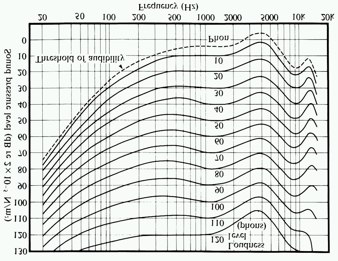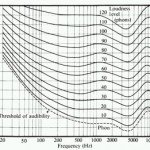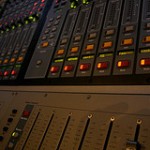
Harsh Reality: Part 2 – A Dynamics Challenge

Inverted Fletcher Munson Contours
In my last post I started talking about Equal Loudness, and the comments seemed to skew more towards considering Equal Loudness for system optimization. While that might factor a bit into where I’m going with all this, that’s not quite what I’m really getting at right now. But for the record, I’m still in the linear PA camp using Smaart, SysTune, SIM, etc., to get there. I’m just not a believer that there is one right way to do things when it comes to the world of audio which is part of why I float Dave Rat’s approach to tuning his PA out there. But I digress…..
So what does Equal Loudness have to do with what we’re doing in church audio? Let’s start with a quote from Bob McCarthy’s book Sound Systems: Design and Optimization as he takes a brief look at the Equal Loudness Contours:
This does, however, put us on notice that in order for listeners at different locations to perceive the same frequency response we will need to match both frequency response and level. If the level is not matched, the listeners will perceive a matched frequency response differently due to their ear’s non-linearity over level.
Bob McCarthy – Sound Systems: Design and Optimization
So we have a challenge, and that challenge relates to a debatable concept: live mix translation outside our room. In this day and age of webcasting, podcasting, and who-knows-what-casting still to come, I believe mix translation is becoming more and more important to what we do with church audio on a weekly basis. This is especially true as budgets and resources become more and more limited, and it really becomes the job of the lone FOH mixer to provide a mix that can literally go around the world. And while the concept of a mix that translates may be true to an extent for just about any mixer in a live environment, I do believe we have a unique challenge that can be difficult for those outside our little church audio niche to understand.
The way I see it, we have a dynamics challenge. The dynamic range of a modern church service can run anywhere from 20-40 dB, and I’m talking RMS levels–not peak to average. However, the range we are probably used to listening to at home or in our car might be closer to 10 dB, and maybe less than that at times. So let’s look a little closer at this.
It seems there are generally two main components to just about every church service these days: talking and music–I’m skipping video for now, but I’ll probably touch on it a bit in another post. I don’t know what other churches are doing, but the volume of talking in our services is usually pretty close to the volume I would listen to talking in my car or at home. It’s almost conversational in level. So going back to system tuning, a linear PA can be great in the case of talking because if it sounds good in the room, in theory, it’s probably going to sound good if I play a recording back somewhere else. We’re mixing near the same level our content will playback in other rooms/environments.
But then there’s that whole music thing. When I talk with other church sound guys, it seems the trend with music these days seems to be moving towards louder music especially with more modern music styles. The result is the level we listen and mix music at for services in our rooms is moving farther away from the level we listen to in smaller environments like our car or home or on an iPod. In fact, the level we’ll listen to music at outside of our rooms is actually probably closer to that same level we’d listen to talking at.
Look back at that Bob McCarthy quote above. Knowing what we know about Equal Loudness, if we are making tonal and mix decisions based on our perception of sound at a given volume that is different from some of the places we’ll listen to it, what happens when we listen to the same mix at that different volume? Think about what will happen if we webcast/broadcast that mix for people to listen to on their laptop speakers or through their TV? When we start to understand equal loudness contours, we can start to see that we are going to perceive things a bit differently at home than how we perceived things in our louder live mix location.
Looking back at Dave Rat’s approach to tuning a system, we know from his video that he gets his tones and balance through headphones. In a way, he’s simulating a studio-esque, controlled environment for his mix. He builds the mix on the console and then modifies the PA so that the mix translates from night to night in different rooms at a volume that is probably quite higher than what he pumps into his ears through a pair of headphones. If those headphones are linear in nature, do you really think his PA’s get tuned to be linear? I haven’t heard Dave’s mixes, but knowing what I know about Equal Loudness, I would guess if he played his headphone mixes back through a linear PA they might lean towards being somewhat bright and harsh.
But back to our audio niche and the big question: Is it really that big of a deal if at most our music is 20 dB or so louder than that studio environment? In fact, how many churches out there even have a 20 dB difference to contend with? I’ll even admit that on paper, the curves might look a little different at a glance. Some might characterize them as subtly different. However, I would contend that the mixing business is all about the manipulation of subtleties.
Up next I’ll start to look at some of my own experiments related to the equal loudness phenomenon and some of the challenges that got me looking more in its direction.

 Previous Post
Previous Post Next Post
Next Post



This is really good info, and very true. Yesterday I did an experiment in our room to see if I could get it sounding better. While the end result was not that great (after 3 hours, it didn’t sound that much better than my previous tune), I did quantify a few of the system’s failings. Chief among them is that we have a nearly 10dB difference in level between the front seating section and the rear. At FOH, where we measure SPL on the weekend, I’m down nearly 7 dB.
When I run those findings through the grid of the Equal Loudness Curves, it’s easy to see why I have so many complaints about the mix not translating correctly in different parts of the room. The good news is, now I know exactly why and I can start talking in clear terms about what’s going on. The bad news is that the fix will be expensive…
I second what Mike is saying. At my church we are about to undertake a “retrofit” of the main PA as we try and spend as little money as possible due to us moving into a new building by the end of 2011 (Lord willing). That being said, I have a 10db difference from the front to the back, and a 5-10 db difference either left or right of the center cluster. Mix position is in the back with the highs and lows finding there way easier to my ears than the mids.
To get back on track, I am really liking your posts and finding them a good refresher on some topics I learned back in school, but never really gave much thought to.
TY
Thanks, Jonathon. I think the hard thing with a lot of audio fundamentals and physics stuff is it often doesn’t seem cool. It’s academic, and I get that. I’d much rather be dialing in a mix than thinking about this stuff. However, the fundamentals such as equal loudness can come in very handy for troubleshooting and mixing once you get a handle on things and start thinking about how to apply the concepts to what you’re doing. I don’t know how necessary it is at the end of the day to understand this stuff to make great music and mixes happen, but for me it has been another tool in the arsenal.
Very interesting posts. But I have attended Buford Jones Mixing workshops from Meyer (as you said – a pro-linear think tank), and he explains in great detail how he did remote mixing for the Tim McGraw/Faith Hill concerts. He mixed FOH from a truck – at much lower volume levels than he would have in the room. He explained that there was a System Engineer in the room, whose job it was to create as linear a system as possible so that Buford would have an “empy palette” on which to work. He then went on to play us some samples of raw recordings from those shows…and they sounded pretty darn CD-quality to me.
So what’s the difference in the “Dave Rat” approach and the “Buford Jones” approach?
Sorry, that should have been, “empty canvas” not palette…duh.
When we got to spend a day with Buford Jones a couple years ago, he told us that story, too. I think there might be a misunderstanding with that word “linear” in that particular case. The question is, were they going for a “linear PA” or a “linear mix translation”? Buford Jones’ mixes are the real deal so I’m sure whatever they did worked. However, if he was working with flat studio monitors in the truck–and to my knowledge he was–they would have had to do something to tame the upper mids in the room along with maybe warming the mix up a bit.
When you mix at low levels and turn it up to concert level, things get bright and painful depending on how loud you go. I’ve heard Buford’s board mixes, and if my memory serves right they were smoking, so I’d feel confident in saying they were doing something on the PA side to make the mix translate if the mix sounded as good in the room as it probably did in the truck. This isn’t really very different from Dave Rat’s approach except Buford mixed in a truck, and Dave mixes in the room.
You can do an experiment yourself. Just take your favorite CD’s from BEFORE the loudness wars. Listen at a low level and then run them up to 101 dBA and listen to what happens.